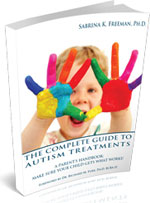Finding effective treatments for their children with autism is one of the most difficult challenges parents face. In this month’s ASAT feature,
Gina Green, PhD, BCBA-D and
Lora Perry, MS, BCBA share insights about the many pseudoscience and antiscience theories and claims that are made about treatments for autism, and suggest some questions parents can ask to help them decide which treatments are most likely to help. To learn more about ASAT, please visit their website at
www.asatonline.org. You can also sign up for ASAT’s free newsletter,
Science in Autism Treatment, and like them on
Facebook!
Science, Pseudoscience and Antiscience Theories in Autism:
Gina Green, PhD, BCBA-D and Lora Perry, MS, BCBA
The Importance of Informed Treatment Decisions
“Your child has autism.” With those words, a parent’s world comes crashing down. What to do? Choosing a treatment is one of the most important decisions the parents of a person with autism will ever have to make. How do parents find truly effective treatment for their child? In an ideal world, the person who dropped the autism diagnosis on a family would provide the answer. But the unfortunate fact is that many who make this diagnosis are not well informed about the wide array of autism treatments, and the degree to which these treatments have proven effective (or not). So until the day comes when parents can count on data based professional guidance, they will need to become very discerning about the various treatments, therapies, and programs that are claimed to be effective for autism. The same applies to those who are concerned with helping families get effective services. There is a need to do a lot of homework, and to do it quickly. Why the urgency? Because the stakes are high, and every moment is precious.
Children and adults with autism can learn, and there are effective methods for helping them develop useful skills and lead happy, productive lives. At the same time, research has shown that many currently available interventions for autism are ineffective, even harmful, while others have simply not been tested adequately. Every moment spent on one of those therapies instead of effective intervention is a moment lost forever. Besides, common sense suggests that it is wise for parents and professionals alike to invest in interventions that can be reasonably calculated to produce lasting, meaningful benefits for people with autism—that is, interventions that have withstood scientific testing.
As parents and professionals seek information about autism treatments, they discover a long and perplexing list of “options,” many of them promoted by sincere, well-meaning, persuasive people. Everyone claims that their favorite treatment works, and parents and practitioners are often encouraged to try a little bit of everything. This can be very appealing to people who are seeking anything that might help. How does one choose wisely? To quote the late Carl Sagan, “The issue comes down to the quality of the evidence.” So the first step is to find out exactly what evidence is available to support claims about autism treatments. But all evidence is not created equal. How does one sort pure hype from solid proof, wishful thinking from rigorous testing?
Science, Pseudoscience, and Antiscience in Autism
Approaches to answering fundamental questions about how the world works can be grouped into three broad categories: science, pseudoscience, and antiscience. Science uses specific, time-honored tools to put hunches or hypotheses to logical and empirical tests. Some of those tools include operational definitions of the phenomena of interest; direct, accurate, reliable, and objective measurement; controlled experiments; reliance on objective data for drawing conclusions and making predictions; and independent verification of effects.
Science does not take assertions or observations at face value, but seeks proof. Good scientists differentiate opinions, beliefs, and speculations from demonstrated facts; they don’t make claims without supporting objective data.
Continue reading →

 When I look back on my own childhood, I think of several behaviors I exhibited: in third grade I cut my own hair while my teacher’s back was turned, in fourth grade I got mad at my brother and threw an alarm clock at him, and in seventh grade I loved Agatha Christie books so much that I frequently refused to go outside and sat in my room reading by myself for hours on end. If I had autism, any one of these behaviors may have been pathologized instead of being considered as just a part of growing up.
When I look back on my own childhood, I think of several behaviors I exhibited: in third grade I cut my own hair while my teacher’s back was turned, in fourth grade I got mad at my brother and threw an alarm clock at him, and in seventh grade I loved Agatha Christie books so much that I frequently refused to go outside and sat in my room reading by myself for hours on end. If I had autism, any one of these behaviors may have been pathologized instead of being considered as just a part of growing up. Learning that your child has autism is incredibly overwhelming. You’re under intense stress to make the best decisions possible for your child, and to do so quickly. Add to the fact that autism is a popular topic in the news and social media, so tips and quick fixes frequently show up in headlines and news feeds. Autism is considered to be a fad treatment magnet, and while some of the fad treatments are ineffective, others are flat out dangerous. How is it possible to parse through all this to find reliable information? Here are a few tips to help you out:
Learning that your child has autism is incredibly overwhelming. You’re under intense stress to make the best decisions possible for your child, and to do so quickly. Add to the fact that autism is a popular topic in the news and social media, so tips and quick fixes frequently show up in headlines and news feeds. Autism is considered to be a fad treatment magnet, and while some of the fad treatments are ineffective, others are flat out dangerous. How is it possible to parse through all this to find reliable information? Here are a few tips to help you out: So where can you find valid information?
So where can you find valid information?